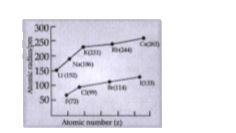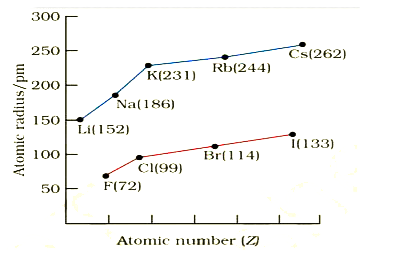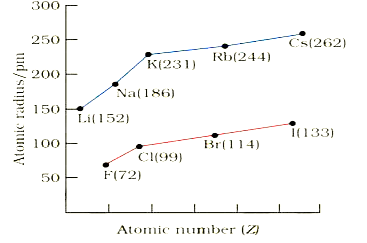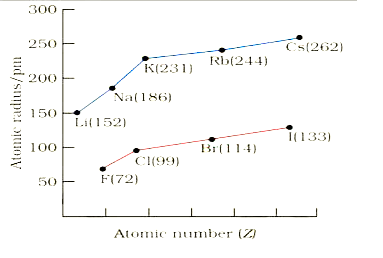Increase in atomic size down the group is due to
Increase in number of ORBIT
Increase in number of protons and neutrons
Increase in number of protons
Increase in number of protons, neutrons and electrons
The correct Answer is:A
Increase in atomic size down the group is due to increase in number of electrons.
Topper's Solved these Questions
- BOOK - ERRORLESS CHAPTER - CLASSIFICATION OF ELEMENTS AND PERIODIC PROPERTIES EXERCISE - Ordinary Thinking Objective Questions Ionisation Energy60videos
CLASSIFICATION OF ELEMENTS AND PERIODIC PROPERTIES
- BOOK - ERRORLESS CHAPTER - CLASSIFICATION OF ELEMENTS AND PERIODIC PROPERTIES EXERCISE - Ordinary Thinking Objective Questions Electron affinity25videos
CLASSIFICATION OF ELEMENTS AND PERIODIC PROPERTIES
- BOOK - ERRORLESS CHAPTER - CLASSIFICATION OF ELEMENTS AND PERIODIC PROPERTIES EXERCISE - JEE Section Matrix Match type questions2videos
CLASSIFICATION OF ELEMENTS AND PERIODIC PROPERTIES
- BOOK - ERRORLESS CHAPTER - CHEMISTRY IN EVERYDAY IN LIFEEXERCISE - Critical Thinking (Objective question )25videos
CHEMISTRY IN EVERYDAY IN LIFE
- BOOK - ERRORLESS CHAPTER - COORDINATION CHEMISTRYEXERCISE - JEE(ADVANCED 2018 MORE THAN ONE CHOICE CORRECT ANSWER1videos
COORDINATION CHEMISTRY
Similar Questions
Read the following and answer the question
Metallic Character:
The ability of an atom to donate electrons and form positive ion (cation) is known as electro-positivity or metallic character. Down the group, metallic character increases due to increase in atomic size and across the period, from left to right electro-positivity decreases due to decrease in atomic size
Non-Metallic Character:
The ability of an atom to accept electrons to form a negative ion (anion) is called non-metallic character or electronegativity. The elements having high electro-negativity have a higher tendency to gain electrons and form anion.
Down the group, electronegativity decreases due to increase in atomic size and across the period, from left to right electro-negativity increases due to decrease in atomic size.

Which of the following correctly represents the decreasing order of metallic character of Alkali metals plotted in the graph ?View SolutionMetallic Character
The ability of an atom to donate electrons and form positive ion (cation) is known as electropositivity or metallic character. Down the group, metallic character increases due to increase in atomic size and across the period, from left to right electropositivity decreases due to decrease in atomic size.
Non-Metallic Character
The ability of an atom to accept electrons to form a negative ion (anion) is called non-metallic character or electronegativity. The elements having high electro-negativity have a higher tendency to gain electrons and form anion.Down the group, electronegativity decreases due to increase in atomic size andacross the period, from left to right electronegativity increases due to decreasein atomic size

Identify the reason for the gradual change in electronegativity in halogensdown the group.View Solution
Knowledge Check
- Question 1 - Select One
Generally the atomic and ionic radii increase with increase in atomic number down the group. But the atomic size of aluminium and gallium is almost the same. This is because
AThe nuclear charge of Ga is higher than that of AlBGallium contains intervening d-electrons which do not not screen the valence electrons effectivelyCthe ionization energies of Ga and Al are comparableDAll of the above. - Question 2 - Select One
Usually the atomic and ionic radii should increase with increasing atomic number down the group. But there is not much increase at Ga and TI in group-13 and is due to
Ahigh ionisation energies of these elementsBthe high nuclear charge of Ga and TlCthe intervening of and f-electronsDNone of the above - Question 3 - Select One
Ionization enthalpy decreases down the group due to gradual increases in atomic size .However the deviation is observed as we move from
ASb toBiBAs toSbCP toAsDN toP
Metallic Character
The ability of an atom to donate electrons and form positive ion (cation) is known as electropositivity or metallic character. Down the group, metallic character increases due to increase in atomic size and across the period, from left to right electropositivity decreases due to decrease in atomic size.
Non-Metallic Character
The ability of an atom to accept electrons to form a negative ion (anion) is called non-metallic character or electronegativity. The elements having high electro-negativity have a higher tendency to gain electrons and form anion. Down the group, electronegativity decreases due to increase in atomic size and across the period, from left to right electronegativity increases due to decrease in atomic size

Which of the following reason correctly justifies that “Fluorine (72pm) has smaller atomic radius than Lithium (152pm)”?View SolutionMetallic Character
The ability of an atom to donate electrons and form positive ion (cation) is known as electropositivity or metallic character. Down the group, metallic character increases due to increase in atomic size and across the period, from left to right electropositivity decreases due to decrease in atomic size.
Non-Metallic Character
The ability of an atom to accept electrons to form a negative ion (anion) is called non-metallic character or electronegativity. The elements having high electro-negativity have a higher tendency to gain electrons and form anion.Down the group, electronegativity decreases due to increase in atomic size and across the period, from left to right electronegativity increases due to decrease in atomic size

Hydrogen is placed along with Alkali metals in the modern periodic table though it shows non-metallic characterView SolutionMetallic Character
The ability of an atom to donate electrons and form positive ion (cation) is known as electropositivity or metallic character. Down the group, metallic character increases due to increase in atomic size and across the period, from left to right electropositivity decreases due to decrease in atomic size.
Non-Metallic Character
The ability of an atom to accept electrons to form a negative ion (anion) is called non-metallic character or electronegativity. The elements having high electro-negativity have a higher tendency to gain electrons and form anion. Down the group, electronegativity decreases due to increase in atomic size and across the period, from left to right electronegativity increases due to decrease in atomic size

Which of the following correctly represents the decreasing order of metallic character of Alkali metals plotted in the graph?View SolutionMetallic Character
The ability of an atom to donate electrons and form positive ion (cation) is known as electropositivity or metallic character. Down the group, metallic character increases due to increase in atomic size and across the period, from left to right electropositivity decreases due to decrease in atomic size.
Non-Metallic Character
The ability of an atom to accept electrons to form a negative ion (anion) is called non-metallic character or electronegativity. The elements having high electro-negativity have a higher tendency to gain electrons and form anion. Down the group, electronegativity decreases due to increase in atomic size and across the period, from left to right electronegativity increases due to decrease in atomic size

Which of the following has highest electronegativity?View SolutionAssertion : Solubility of alcohols in water decreases with the increase in the molecular mass.
Reason : The increase in the size of the alkyl group increases the polar nature of O−H group.View Solution

